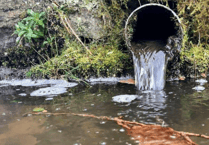CEREDIGION council is quite wrong to threaten to sue governors of four village schools.
Putting the frighteners on pillars of the community struggling to safeguard their children’s best interests is no way to resolve an allegation over the authority’s handling of its reckless plan - now abandoned - to shut schools at Borth, Llanfihangel y Creuddyn, Llangwyryfon and Ponterwyd.
The move is particularly misplaced given that, more than a month ago, the council backtracked after lawyers for the schools applied for a judicial review of the closure proposals at the high court in Cardiff. All four will now stay open.
Against this background, how odd it is that the chairs of governors have now been threatened with being sued for defamation after claiming in a letter to the council’s cabinet that chief executive Eifion Evans and corporate director Barry Rees “misled” councillors over the legality of launching a formal consultation on the closures.
Enter senior barrister Mark Powell KC. He tells the governors their letter has the potential to cause severe reputational damage to Evans and Rees and “renders you liable for a claim for substantial damages for damages which would lie against you personally”.
If they were sued, he adds, they would not be covered by insurance arising from their position as governors, and their suitability as governors could be called into question.
Forefinger wagging furiously, Powell ends his letter: “There must be no more repetition of these allegations…to avoid the necessity of a claim for defamation against you.” So there.
Correspondence like this would guarantee a bad start to anyone’s day and could put you right off your morning tea and toast.
However, it prompts the question of why the council so often seems content to antagonise and alienate the public.
Why did the cabinet go off the deep end and summon a lawyer who will no doubt feel obliged to invoice the council for unknown thousands?
Instead, they could have empathised with parents and governors still reeling from the shock and stress of fighting for the survival of all-important schools and, by extension, villages.
The point is that destroying these schools and all they represent was never justified. Even financially, it’s likely that savings would, individually, have been little different from the high cost of hiring a barrister, a bill which will now be laid at the door of council tax-payers. They it is who will pick up the tab for delicate egos.
Going to law was gross over-reaction. Incurring unnecessary spending at a time when the council is constantly protesting it’s broke is sheer indulgence. The cabinet should have actively sought conciliation with the governors.
That would have cost nothing and may have helped mend fences with a public increasingly openly hostile towards an authority which far too often crashes through public opinion in pursuance of pet schemes.
Rearranging Aberaeron’s streets and threatening economic mayhem and severe social damage by obliterating Aberystwyth seafront parking - while charging a fortune for what’s left - come easily to mind.
FOR THE last 73 years, radioactive waste from Cumbria’s Sellafield nuclear site has contaminated seas off vast coastal areas of Wales and Ireland. Some of these hazardous substances take, literally, tens of thousands of years to decay.
Sellafield’s notoriety is legendary. Since 1952, it has openly discharged vast amounts of liquid and solid radioactive waste into the Irish Sea. This stuff has been detected off coasts of Wales, as well as hundreds of miles further south and west of the Cumbria nuclear site.
We’re talking here about insoluble radionuclides, such as highly dangerous plutonium-239, which has a half life of, truly, 24,110 years and can attach to particles in the sea, there to be transported over long distances and timescales and ultimately deposited into fine sediments. such as estuarine and coastal mudflats and salt-marshes.
This stuff has floated unhindered from Sellafield to Wales’s west coast, ending up as far away as the Bristol Channel and the southern North Sea.
Sellafield’s tentacles have even reached inland Wales. In the late 1980s, the then Dyfed County Council commissioned a study of radioactivity in the county which found Caesium-137 - proved to have come from Sellafield sea discharges - in pasture grass seven miles inland from the Cardigan Bay coast. Radiocaesium, which has a 30-year half-life, can increase the risk for cancer.
For Wales, Sellafield is a running sore.
Two years ago, this column revealed a plan to bury large amounts of Sellafield’s lethal waste in the seabed off Wales.
Nuclear Waste Services (NWS), a taxpayer-funded public body under the wing of the UK government, engaged marine geological surveyors to comb the seabed for an out-of-sight-out-of-mind repository for the terrifying remnants of a dangerous and long discredited system of energy-generation.
An NWS boat trudging the Irish Sea just off Cardigan Bay was told to blast off underwater seismic guns - to the certain detriment of dolphins and porpoises - as part of the quest for a dumping ground for Sellafield’s detritus.
Potentially, what this meant, and may still mean, is that Wales, Ireland and western England would have imposed on them the world’s biggest stockpile of untreated nuclear waste, including 100 tonnes of plutonium.
The hunt for a site for what NSW describes sweetly as a geological disposal facility (GDF) appears now to have moved inland - to Mid Copeland and South Copeland, Cumbria, and Theddlethorpe, Lincolnshire - though the Irish Sea has never officially been discounted.
Meanwhile, for coastal areas of Wales and Ireland, Sellafield’s wretched influence lives on, with the Environmental Protection Agency (EPA) reporting that artificial radioactivity can still be detected in Irish Sea sediments, seawater, seaweeds, fish and shellfish.
Added to which a report by Whitehall’s spending watchdog - the National Audit Office - warns a storage silo at Sellafield is daily leaking about 2,100 litres of radioactive water into the ground and, therefore, ultimately into the sea. Transferring its contents to safer facilities will take till the late 2050s, with “significant safety and financial consequences”.
This ageing building sprang its leak in 2019, but because of extreme hazards in accessing the building the leak can’t be fixed, meaning it is poised to persist for another 30 years.
Wales could do with an assurance that the Welsh government is keenly aware of this entire enduring nightmare.
RUNNING order of 6pm news, BBC Radio 4, Saturday 4 January:
1: the British victim of an attack in New Orleans was Prince William’s nanny;
2: a warning about snow and ice across Wales and England;
3: More than 136 civilians have reportedly been killed by Israeli military in attacks in Gaza in the last 48 hours.
Evidently, the BBC assesses relative newsworthiness of tragic events not according to scale or seriousness but based on who the victims are.
If 136 Britons, or other westerners, had been killed in military attacks, little else would have got a look-in in terms of air-time. Where the deaths are of Palestinians, it’s a different story. The BBC needs to tell us why.
.png?trim=0,2,0,1&width=752&height=501&crop=752:501)




Comments
This article has no comments yet. Be the first to leave a comment.